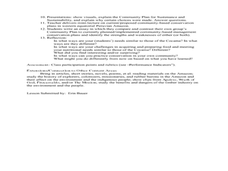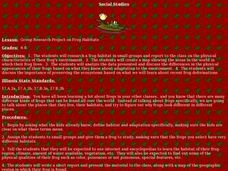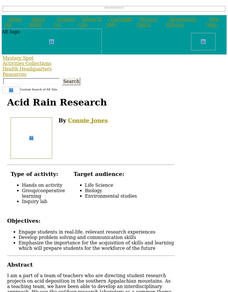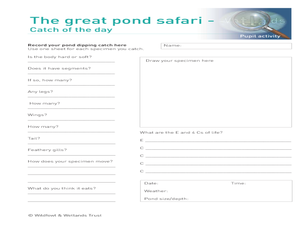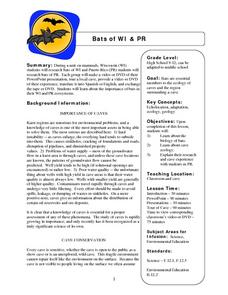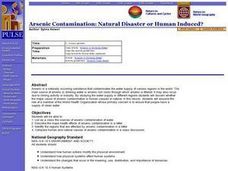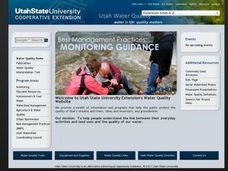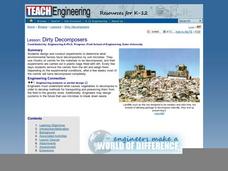Curated OER
Supermarkets, Sustenance and Sustainability
Students investigate jungles and the people who depend upon them. In this sustainability lesson, students research wild life conservation and discover the importance of a jungle to Amazonian people. Students create a group...
Curated OER
Fashion Forward, Fashion Functional
Students consider the implications of waste. In this waste streams instructional activity, students learn what waste streams are and identify their impact on the environment. Students also recycle waste materials to create functional...
Curated OER
Is Environmental Health a Basic Human Right?
High schoolers examine basic human rights as defined by the United Nations. They develop a list of rights by class consensus, read an article, answer discussion questions, and complete a worksheet.
Curated OER
Move To a Healthier Aquatic Balance
Fourth graders examine aquatic orgnaisms and how enviromental chages affect them. This factors include: temperature, Ph, oxygen, nutrients, and pollutants. They also explore habitat quality (erosion). Students compile data and create...
Curated OER
Sustainable Agriculture
Learners perform an experiment to find out if plants grow best when grown in soil with no fertilizer, with chemical fertilizers, or with compost that they have made themselves. Students discover how agriculture practices can benefit the...
Curated OER
Learning From Leaves: A Look at Leaf Size
Students measure and analyze leaves from various environments. They discuss the environments, and make inferences about environmental variables that could have contributed to the differences in leaf size and texture.
Curated OER
Making Mummies
Students examine how mummies are made. In this ancient mummification lesson, students discover types of mummies and discuss the environments naturallly preserve bodies. Students research noteable mummy discoveries and present...
Curated OER
Ecological Impact of Cyanide Heap Leaching
Students explore the environment by researching mining. In this ecological dangers lesson, students define cyanide and discuss why it has potential to be a great threat to our environment during mining expeditions. Students examine many...
Curated OER
Know Your Watershed
Learners investigate the importance and the location of their own watershed by visiting and EPA website and also work in groups to create an action plan on how to protect their local watershed.
Curated OER
Group Research Project on Frog Habitats
Learners identify and research a frog habitat in small groups and compile a report to present to the class on the physical characteristics of their frog's environment. Students create a map illustrating areas in the world where their...
Curated OER
What are Properties of Wood?
Students use hands on scientific observation to determine characteristics of wood. They work directly with the materials and record their observations. Students test if wood absorbs water, if wood floats or sinks, and if all wood...
Curated OER
What Makes A Community Sustainable
In this environment worksheet, high schoolers read three different case studies in order to apply them to the categories of finding the best possible choices to make for helping a community flourish.
Curated OER
Currents 2003
In this environment worksheet, students read an article about growth and development of population and the environment. They respond to various types of questions throughout the article packet pertaining to what they read and why.
Curated OER
Needs and Wants
Young scholars examine the difference between needs and wants. In this consumption lesson, students illustrate their needs and wants and discuss their own reasons for buying things. They also discuss the connection between their...
Curated OER
Acid Rain Research
Students collect samples of rainfall, cloud condensation, and water that trickles through the soil. These samples are tested for pH, conductivity, and the presence of sulfates, nitrates, calcium, and magnesium.
Curated OER
Greenhouse Gases: The Chemistry Behind the Culprits
Ninth graders investigate the effect of different gases in the atmosphere. In this chemistry lesson, 9th graders explain how these gases contribute to global warming. They suggest possible solutions to this growing problem.
Curated OER
Pond Safari
Students investigate organisms and animals by examining a nearby pond. In this ecosystem lesson, students participate in a field trip to a local pond where they utilize a net to gather animals, plants and pollution items, Students...
Curated OER
Everyday vs. Extreme Relationships with Nature
Young scholars examine the interactions with nature and the environment. They discover where water comes from and ways to conserve water. They also examine energy sources and consumption.
Curated OER
Bats Of WI And PR
Students investigate the bats of Puerto Rico. They conduct research in order to find information to construct a powerpoint presentation. They create a dvd of the presentation and go on a tour to a local cave to see the environment where...
Curated OER
Arsenic Contamination: Natural Disaster or Human Induced?
Young scholars list as a class the sources of arsenic contamination of water. They describe the major health effects of arsenic contamination in a letter. Students identify the regions that are affected by it.
Curated OER
State Report Card
Twelfth graders evaluate their own state on how well the government protects their citizens from specific health issues. In groups, they list the environmental health concerns regarding water, air, toxic waste and radiation. They...
Curated OER
That Is Predictable
Students investigate the changes that can take place in an aquatic environment. They conduct research using a variety of resources. The research is used to report different possibilities of change because of abiotic or biotic factors.
Curated OER
Lâlâkea Stream: Diversion and Restoration
Students research the history of the Lalakea stream diversion and restoration. They examine the restoration project from multiple viewpoints and consider how it affects the stream-related environments.
Curated OER
Dirty Decomposers
Seventh graders design and conduct experiments to determine what environmental factors favor decomposition by soil microbes. They use chunks of carrot for the materials to be decomposed, and their experiments are carried out in plastic...
